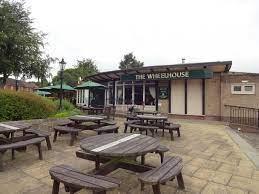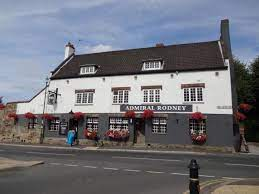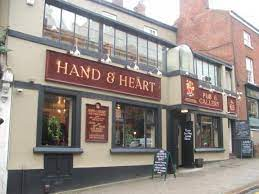The town of Stapleford lies on the border of Nottinghamshire and Derbyshire, close to both the River Trent and the River Erewash, which divides the town from nearby Sandiacre. The origins of Stapleford can be traced to before Norman times. There is a Saxon stone cross in the churchyard of St. Helen's Church which is said to be the oldest stone memorial in the Midlands. Stapleford owes much of its development to the proximity of the two rivers, which made it an important area for trade. It also expanded in the 18th Century when the stocking hose trade thrived in the area, evidence of which can still be found in the Stocking Knitters Houses that still exist on Nottingham Road. The central crossroads of the town is called The Roach, a name that derives from the time when French prisoners from the Napoleonic Wars were set the task of cutting through rock to create roads and this was referred to as 'La Roche'. The town also features two significant landmarks, The Hemlock Stone on Stapleford Hill and, more recently, the excellent Full Mash brewery.
The first destination on our survey was the Man of Iron, situated on Pasture Road, on the edge of the town.
After some bus stop related confusion, we entered the premises, which is operated under Hardy & Hansons and named for the local term for a blacksmith. It soon became obvious that this is a traditional locals pub, with lots of sofas and low seating, a pool table, dart board, jukebox and a TV, currently showing Bargain Hunt with the volume up. The bar is situated to the immediate left of the entrance and there is a significant shortage of the good stuff. There are 2 standard hand pumps, 1 of which is not in use, the other being Abbot Ale. There are also 2 smooth flow pumps, containing Greene King IPA Chilled and Hardy and Hansons Dark. Matt opted for the latter whilst I swallowed my pride and went for a pint of Abbot Ale, which was in good condition thankfully. This pub was more or less what I'd imagined it would be, although it could've done without the landlady shouting at her son as soon as we entered but you can't have everything. We moved on to our next target, hoping for better things.
Next up was The Chequers Inn on the corner of Nottingham Road and Church Street, which I'd heard rumours about being rather good. Sadly, I can't remember where I heard these rumours, which is just as well.
This roughly L-shaped, white building has peeling paint on the exterior but, not wanting to judge a book by its cover, we were undeterred. The pub has two bars, one on a lower level and one at ground level. Our attempt to enter the lower bar was thwarted by someone, presumably the landlord, telling us that the downstairs bar was closed and to head upstairs. This, again, was not a problem, as it was still early in the day. Upon entering the top bar however, we were unimpressed. The bar is small, rectangular and situated in the corner immediately inside the door. Despite our high hopes, there were no handpulls on show, with 2 rows of standard taps greeting us. The only thing remotely ale related was something called Mann's Chestnut Mild. We both decided on a pint of this, hoping at least that the beer was good. As you can probably gather, this again proved to be a false dawn. The mild was dark and creamy but distinctly watery and rather bland. The bar area itself was of a standard layout with bare wooden floors and seating and a raised area at the back with a pool table and dart board. We discussed this place later and are of the opinion that perhaps we'd come at the wrong time of the day and that the good rumours I'd heard perhaps related to the lower bar, which may have had hand pumps for all we knew and, obviously, they presumably would've been considerably busier in the evening. So far though, our ale trail through Stapleford was not going according to plan. I knew things would improve though, thanks in huge part to our next destination.
Situated almost opposite the Chequers, The Horse and Jockey is CAMRA LocAle pub of the year 2013 and it shows, almost upon entry.
The pub dates from 1740 and is a two-storey, white, brick building with a small staircase heading up to the front door. Inside, the layout is roughly square with wooden floors, high tables, low sofas and the bar at the back of the room. The bar is fantastic both aesthetically and because of its products. One half of the back bar is all spirits whilst the other is devoted entirely to whiskies and there are very many of those available. Ale is the reason we've come though and we're certainly not disappointed, with 10 hand pulls from a variety of breweries, both local and further afield. There is also a selection of real ciders available, something which impressed Matt no end. After a few moments of deciding, we made our selections. I went for the pub's own ale, called simply Horse and Jockey, and brewed by nearby Full Mash. At 3.8%, this is pale, very clear, hoppy and smooth with a decidedly fruity finish. Matt likes dark beer where he can get it so he went for Woild Moild from Norfolk's Wolf Brewery, which was very dark, creamy and smooth with a soft finish. They were both very tasty, so much so that we decided to have a second pint here, largely to erase the memory of the previous 2 places we'd visited. My next choice was Beau Douro, brewed by The Wellington Inn in Hull. This is pale, citrusy and has a hop kick that belies it's 4.3% ABV. Matt opted for Tuck, a porter from Hucknall's Lincoln Green brewery. This was brimming with coffee flavours and hint of chocolate malt and went down very well indeed. The Horse and Jockey had certainly banished the issues of the day so far and we were in much better spirits by the time we headed to our next destination, The Pavilion on Derby Road.
As the name suggests, this is an old cricket pavilion with a mostly open plan layout, with a large proportion of high seating, a long bar opposite the front windows, pool tables and a table football set. The main sign out the front advertises FREE BEER, only for it to read Free Wifi and Guest Beer as you get closer and the small print becomes more obvious. There are 4 hand pulls on show, all in use and all, uniquely for Stapleford it seems, containing real cider, including Old Rosie, Country Perry and Matt's choice, Weston's Wild Wood. My initial survey only spotted Caffrey's on a normal smooth flow tap until I noticed a small range of bottled ales in the fridge. The selection wasn't bad: Hobgoblin, Spitfire and Thwaites' Wainwright (4.1%). I went for the latter and it was quite good, golden and very sweet with a citric backbone. Bottled ale is an unusual thing for me to drink in pubs so this was worth the visit for the novelty alone. All in all, The Pavilion wasn't too bad, not perfect but considerably better than a few other places.
Next up, was the local Wetherspoons, located just down the road from The Pavilion. The Admiral Sir John Borlase Warren shares its name with a pub in Nottingham, as well as another, now closed in Loscoe.
It occupies a site near where Stapleford Hall used to stand and is named after Stapleford's local hero, who was born at the hall in 1753. He joined the Navy and rose quickly through the ranks, eventually becoming Admiral. He was also Ambassador to the Russian Court and an MP for Nottingham from 1796-1806. The hall itself was demolished in 1935 and The Warren Arms, built in 1750 and named for the family, used to stand opposite the Wetherspoons until it was demolished in 2009, despite protests. Inside, this is one of the nicest Wetherspoons I've ever been in. The layout is almost that of a manor house, with a long staircase to the upstairs toilets, lots of booth-like seating and ornamental cannons, both in the toilets and the bar, as well as full size relic greeting you upon entry. Several of the mirrors around the room are done in the style of portholes. Wetherspoons are certainly doing their bit to promote real ale and this one is no exception, with 10 hand pumps, split between 2 groups of 5 on either side of the till points. The bar is at the very back of the room, so there is plenty of time to decide what you want on the long walk over. 5 of the offerings are mild, with the other 5 being a standard selection. I shelled out for Nautical Mild from Titanic brewery and it was very nice indeed, malty and smooth with an unusual but welcome hoppy tinge to the aftertaste. Matt opted for Burton Bridge's Moorish Mild (3.9%), which he seemed to greatly enjoy, with its slightly fruity nose, low bitterness and pleasant aftertaste.
We were both rather hungry by now but decided to negate food in order to reach our last pub, with the promise of a trip to Gregg's on the way back to the bus stop. At the very end of Derby Road, just before the bridge that crosses the Erewash into Sandiacre, is our final destination, The Midland.
I was hopeful that this would be impressive and the pub itself wasn't too bad. The choice of ale was disappointing however. The layout was much what we expected, with a central U-shaped bar and seating around the edge spreading across the room. Of the 2 hand pumps available, 1 is not being used whilst the other is promoting Doom Bar which, in the absence of other options, we ordered a pint of each. The quality of Doom Bar has declined noticeably in recent years and whether this is too with its seeming prevalence in many premises. Following the quick consumption of these, we thought it was time to head home, with the aforementioned Gregg's stop taking first priority. On our bus journey back, we were able to discuss our day and agreed, that whilst Stapleford is, with a couple of notable exceptions, lacking in decent real ale outlets, it has certainly been an enjoyable afternoon and much more fun than doing the same thing alone. Next week, we expect to be doing something similar around the upper echelons of Mansfield Road, which I'm rather excited about, as it will include several pubs that I've never visited. However, as always, nothing is certain, but watch this space, as another excursion, somewhere, will be taking place regardless.
















